The Economic Feasibility of Passive Houses in Korea
Abstract
:1. Introduction
2. Building Energy State in South Korea
- a.
- Prerequisite: Buildings that require zero-energy building certification must be buildings with an energy efficiency rating of 1++ or 1+++ (Table 1).
- b.
- Level: Zero-energy building (ZEB) level is divided into five levels according to the ratio of renewable (primary) energy rate for the required primary energy (kW/m2·year), as shown in Table 2.
3. Research Method
3.1. Energy Performance Analysis
3.2. Economic Feasibility
4. Energy Performance Analysis
4.1. Energy Consumption Status at the Reference Building
4.2. Energy-Saving Effect of the Measures
5. Economic Analysis of ECMs
5.1. Payback Period and LCC Analysis
5.2. Assessment of Incentive Policies
6. Discussion and Conclusions
Author Contributions
Acknowledgments
Conflicts of Interest
References
- Dulac, J.; LaFrance, M.; Trudeau, N.; Yamada, H. Transition to Sustainable Buildings: Strategies and Opportunities to 2050; International Energy Agency (IEA): Paris, France, 2013; pp. 22–45. ISBN 978-92-62-20241-2. [Google Scholar]
- Audenaert, A.; De Cleyn, S.H.; Vankerckhove, B. Economic analysis of passive houses and low-energy houses compared with standard houses. Energy Policy 2008, 36, 47–55. [Google Scholar] [CrossRef]
- Mahdavi, A.; Doppelbauer, E. A performance comparison of passive and low-energy buildings. Energy Build. 2010, 42, 1314–1319. [Google Scholar] [CrossRef]
- Passive House Institute. Criteria for the Passive House, EnerPHit and PHI Lower Energy Building Standard. Available online: https://passiv.de/downloads/03_building_criteria_en.pdf (accessed on 9 September 2018).
- Passive House Institute. About Passive House—What is a Passive House? Available online: www.passiv.de (accessed on 8 July 2018).
- Bowerbank, A. SmartMarket Report: Global Green Building Trends-Market Growth and Perspectives from around the World; McGraw Hill Construction: New York, NY, USA, 2008; pp. 2–29. ISBN 978. [Google Scholar]
- Wei, X.; Shicong, Z. APEC 100 Best Practice Analysis of Nearly/Net Zero Energy Building; Asia-Pacific Economic Cooperation (APEC): Singapore, 2017; pp. 15–59. ISBN 978-981-11-3511-8. [Google Scholar]
- International Energy Agency (IEA). Modernising Building Energy Codes: To Secure Our Global Energy Future. Available online: www.iea.org (accessed on 8 July 2018).
- Hinge, A.; Cullen, A.; Neely, B.; Taylor, C. Building Energy Rating Schemes Around The World: What Do We Know? In Proceedings of the ACEEE Summer Study on Energy Efficiency in Buildings, Pacific Grove, CA, USA, 17–22 August 2014. [Google Scholar]
- PassREg Brochure. Defining the Nearly Zero Energy Building: Passive House + Renewables—Municipalities Lead the Way. Available online: www.passivehouse-international.org (accessed on 10 July 2018).
- Sadineni, S.B.; Madala, S.; Boehm, R.F. Passive building energy savings: A review of building envelope components. Renew. Sustain. Energy Rev. 2011, 15, 3617–3631. [Google Scholar] [CrossRef]
- Sozer, H. Improving energy efficiency through the design of the building envelope. Build. Environ. 2010, 45, 2581–2593. [Google Scholar] [CrossRef]
- Mwasha, A.; Williams, R.G.; Iwaro, J. Modeling the performance of residential building envelope: The role of sustainable energy performance indicators. Energy Build. 2011, 43, 2108–2117. [Google Scholar] [CrossRef]
- Aditya, L.; Mahlia, T.M.I.; Rismanchi, B.; Ng, H.M.; Hasan, M.H.; Metselaar, H.S.C.; Muraza, O.; Aditiya, H.B. A review on insulation materials for energy conservation in buildings. Renew. Sustain. Energy Rev. 2017, 73, 1352–1365. [Google Scholar] [CrossRef]
- Biswas, K.; Shrestha, S.S.; Bhandari, M.S.; Desjarlais, A.O. Insulation materials for commercial buildings in North America: An assessment of lifetime energy and environmental impacts. Energy Build. 2016, 112, 256–269. [Google Scholar] [CrossRef]
- Wang, Y.; Kuckelkorn, J.; Zhao, F.Y.; Liu, D.; Kirschbaum, A.; Zhang, J.L. Evaluation on classroom thermal comfort and energy performance of passive school building by optimizing HVAC control systems. Build. Environ. 2015, 89, 86–106. [Google Scholar] [CrossRef]
- Wang, Y.; Kuckelkorn, J.M.; Zhao, F.Y.; Mu, M.; Li, D. Evaluation on energy performance in a low-energy building using new energy conservation index based on monitoring measurement system with sensor network. Energy Build. 2016, 123, 79–91. [Google Scholar] [CrossRef]
- Figueiredo, A.; Figueira, J.; Vicente, R.; Maio, R. Thermal comfort and energy performance: Sensitivity analysis to apply the passive house concept to the Portuguese climate. Build. Environ. 2016, 103, 276–288. [Google Scholar] [CrossRef]
- Dodoo, A.; Gustavsson, L.; Sathre, R. Primary energy implications of ventilation heat recovery in residential buildings. Energy Build. 2011, 43, 1566–1572. [Google Scholar] [CrossRef]
- Fouih, Y.E.; Stabat, P.; Riviere, P.; Hoang, P.; Archambault, V. Adequacy of air-to-air heat recovery ventilation system applied in low energy buildings. Energy Build. 2012, 54, 29–39. [Google Scholar] [CrossRef]
- Badescu, V.; Staicovici, M.D. Renewable energy for passive house heating model of the active solar heating system. Energy Build. 2006, 38, 129–141. [Google Scholar] [CrossRef]
- Chan, H.Y.; Riffat, S.B.; Zhu, J. Review of passive solar heating and cooling technologies. Renew. Sustain. Energy Rev. 2010, 14, 781–789. [Google Scholar] [CrossRef]
- Badescu, V. Economic aspects of using ground thermal energy for passive house heating. Renew. Energy 2007, 32, 895–903. [Google Scholar] [CrossRef]
- Chel, A.; Janssens, A.; Paepe, M.D. Thermal performance of a nearly zero energy passive house integrated with the air-air heat exchanger and the earth-water heat exchanger. Energy Build. 2015, 96, 53–63. [Google Scholar] [CrossRef]
- Passive House Database. Certified Buildings Map. Available online: https://database.passivehouse.com/buildings/map/ (accessed on 10 July 2018).
- Williams, K.; Dair, C. What is stopping sustainable building in England? Barriers experienced by stakeholders in delivering sustainable development. Sustain. Dev. 2007, 15, 135–147. [Google Scholar] [CrossRef]
- World Wide Fund (WWF). Building towards Sustainability: Performance and Progress among the UK’s Leading Housebuilders. Available online: https://www.wwf.org.uk (accessed on 12 July 2018).
- Dowson, M.; Poole, A.; Harrison, D.; Susman, G. Domestic UK retrofit challenge: Barriers, incentives and current performance leading into the Green Deal. Energy Policy 2012, 50, 294–305. [Google Scholar] [CrossRef] [Green Version]
- Zhang, X.; Platten, A.; Shen, L. Green property development practice in China: Costs and barriers. Build. Environ. 2011, 46, 2153–2160. [Google Scholar] [CrossRef]
- Baek, C.; Park, S. Policy measures to overcome barriers to energy renovation of existing buildings. Renew. Sustain. Energy Rev. 2012, 16, 3939–3947. [Google Scholar] [CrossRef]
- Osmani, M.; O’Reilly, A. Feasibility of zero carbon homes in England by 2016: A house builder’s perspective. Build. Environ. 2009, 44, 1917–1924. [Google Scholar] [CrossRef] [Green Version]
- International Passive House Association (iPHA). Active for More Comfort: Passive House. Available online: www.passivehouse-international.org (accessed on 10 July 2018).
- Coyle, D. An Investigation into the Cost Optimality of the Passive House Retrofit Standard for Irish Dwellings Using Life Cycle Cost Analysis. J. Sustain. Des. Appl. Res. 2016, 4, 5–14. [Google Scholar]
- Pitts, A. Passive House and Low Energy Buildings: Barriers and Opportunities for Future Development within UK Practice. Sustainability 2017, 9, 272. [Google Scholar] [CrossRef]
- Gillingham, K.; Newell, R.G.; Palmer, K. Energy Efficiency Economics and Policy. Annu. Rev. Resour. Econ. 2009, 1, 597–620. [Google Scholar] [CrossRef] [Green Version]
- DODGE Data & Analytics. World Green Buildings Trends 2016: Developing Markets Accelerate Global Green Growth. Available online: www.construction.com (accessed on 15 July 2018).
- Halil, F.M.; Nasir, N.M.; Hassan, A.A.; Shukur, A.S. Feasibility Study and Economic Assessment in Green Building Projects. Procedia Soc. Behav. Sci. 2016, 222, 56–64. [Google Scholar] [CrossRef]
- Bause, K.; Radimersky, A.; Iwanicki, M.; Albers, A. Feasibility Studies in the Product Development Process. In Proceedings of the CIRP 24th Design Conference 2014, Milan, Italy, 14–16 April 2014. [Google Scholar]
- Frappe-Seneclauze, T.P.; Heerema, D.; Wu, K.T. Accelerating Market Transformation for High-Performance Building Enclosures: State of Market, Policy Developments, and Lessons Learned from the Passive House Movement; PEMBINA Institute: Calgary, AB, Canada, 2016; pp. 21–93. [Google Scholar]
- Berry, S.; Davidson, K. Zero energy homes—Are they economically viable? Energy Policy 2015, 85, 12–21. [Google Scholar] [CrossRef]
- BP Statistical Review of World Energy June 2016. Available online: http://www.bp.com (accessed on 11 July 2018).
- McNamara, K.; Robertson, A.; Cameron, R.; Nishida, Y.; Tonai, A.; Yabumoto, A. Energy Policies of IEA Countries: The Republic of Korea; International Energy Agency (IEA): Paris, France, 2012; pp. 15–48. ISBN 978. [Google Scholar]
- Nejat, P.; Jomehzadeh, F.; Taheri, M.M.; Gohari, M.; Majid, M.Z.A. A global review of energy consumption, CO2 emissions and policy in the residential sector (with an overview of the top ten CO2 emitting countries). Renew. Sustain. Energy Rev. 2015, 43, 843–862. [Google Scholar] [CrossRef]
- Korea Energy Economics Institute. Analysis of Building Energy Efficiency Elements in Market and Suggestion of Improvement Plan. Available online: http://www.keei.re.kr/ (accessed on 13 August 2018). (In Korean).
- Schuetze, T. Zero Emission Buildings in Korea-History, Status Quo, and Future Prospects. Sustainability 2015, 7, 2745–2767. [Google Scholar] [CrossRef]
- Evans, M.; Chon, H.; Shui, B.; Lee, S.E. Country Report on Building Energy Codes in Republic of Korea; Pacific Northwest National Laboratory: Oak Ridge, TN, USA, 2009; pp. 1–13. [Google Scholar]
- Korea Energy Agency. Available online: www.energy.or.kr/ (accessed on 16 August 2018).
- NRDC. Paris Climate Conference: South Korea. Available online: www.nrdc.org/ (accessed on 15 July 2018).
- Korean Government. Five-Year Plan for Green Growth. Available online: www.climate.go.kr/ (accessed on 17 July 2018).
- Vallentin, G.; Cho, Y.B. Cooperation passive house between planners in Korea and Germany. In Proceedings of the Internationale Passivhaustagung 2011, Innsbruck, Austria, 27–29 May 2011. [Google Scholar]
- Kim, S.W.; Cho, J.H.; Kwon, W.; Son, B.S.; Chun, J.Y. Status and Making Strategies for Comparative Analysis of the Domestic Passive House. Korea J. Constr. Eng. Manag. 2012, 11, 517–518. (In Korean) [Google Scholar]
- Construction & Building Technologies Korea Market Study. Available online: www.eu-gateway.eu (accessed on 17 July 2018).
- The Certified Status of Building Energy Rating System in 2017. Available online: www.molit.go.kr/ (accessed on 11 July 2018).
- Korean Statistical Information Service (KOSIS). Housing Type and Unit per Housing Area. Available online: www.kosis.kr/eng/ (accessed on 13 July 2018).
- Energyplus. Available online: https://www.energyplus.net (accessed on 10 July 2018).
- ASHRAE. ANSI/ASHRAE/IES Standard 90.1-2013, Energy Standard for Buildings Except Low-Rise Residential Buildings; American Society of Heating, Refrigerating and Air-Conditioning Engineers: Atlanta, GA, USA, 2013; pp. 87–103. [Google Scholar]
- Ahn, N.; Cho, M.G.; Choi, J.M. A study on airtightness performance analysis of low-energy house in Korea. J. Korean Sol. Energy Soc. 2013, 4, 334–338. (In Korean) [Google Scholar]
- Ministry of Land. Infrastructure and Transport. Building Design Criteria for Energy Saving. Available online: building.energy.or.kr (accessed on 20 July 2018). (In Korean)
- Ministry of Land. Infrastructure and Transport, the Regulation of Building Energy Efficiency Rating System: Residential Building and Non-Residential Building Usage Profile. Available online: https://www.energy.or.kr (accessed on 20 July 2018). (In Korean)
- Galvin, R. Are passive houses economically viable? A reality-based, subjectivist approach to cost-benefit analyses. Energy Build. 2014, 80, 149–157. [Google Scholar] [CrossRef]
- Badea, A.; Baracu, T.; Dinca, C.; Tutica, D.; Grigore, R.; Anastasiu, M. A life-cycle cost analysis of the passive house “POLITEHNICA” from Bucharest. Energy Build. 2014, 90, 542–555. [Google Scholar] [CrossRef]
- Raustad, R. Developing Natural Gas Cost Escalation Rates for the Associated Gas Distributors of Florida; Florida Solar Energy Center: Cocoa, FL, USA, 2010; pp. 1–16. [Google Scholar]
- Janis, R.; Tao, W. Mechanical and Electrical Systems in Buildings, 4th ed.; Pearson: New York, NY, USA, 2008; pp. 15–20. ISBN 978-0135130131. [Google Scholar]
- The Bank of Korea. Available online: www.bok.or.kr (accessed on 20 July 2018).
- Korea Electric Power Corporation (KEPCO). Available online: home.kepco.co.kr (accessed on 20 July 2018).
- Korea District Heating Corporation. Available online: www.kdhc.co.kr (accessed on 20 July 2018).
- Korea National Statistical Office. Consumer Price Index. Available online: http://www.index.go.kr (accessed on 20 July 2018).
- Hong, T.; Langevin, J.; Sun, K. Building simulation: Ten challenges. Build. Simul. 2018, 11, 871–898. [Google Scholar] [CrossRef] [Green Version]
- ASHRAE. ASHRAE Guideline 14-2002: Measurement of Energy and Demand Savings; American Society of Heating, Refrigerating and Air-Conditioning Engineers: Atlanta, GA, USA, 2002; pp. 10–21. [Google Scholar]
- Feist, W.; Schnieders, J.; Dorer, V.; Haas, A. Re-inventing air heating: Convenient and comfortable within the frame of the Passive House concept. Energy Build. 2005, 37, 1186–1203. [Google Scholar] [CrossRef]
- DIN. DIN 1946-6:2009-05: Raumlufttechnik—Teil 6: Lüftung von Wohnungen; Beuth: Berlin, Germany, 2009; pp. 1–125. ISBN 9783410252139. [Google Scholar]
- Policies Related to Energy-Using Machinery. Equipment or Materials and Energy-Related Machinery, Equipment or Materials. Available online: http://www.data.go.kr/ (accessed on 20 July 2018).
- Pfluger, R.; Hasper, W.; Feist, W.; Rojas-Kopeinig, G. Energy and Cost Efficient Ventilation Systems with Heat Recovery-State of the Art and Enhancement (DE-13-021). In Proceedings of the 2013 ASHRAE Annual Conference, Denver, CO, USA, 22–26 June 2013. [Google Scholar]
- Passive House Institute Korea. Available online: http://www.phiko.kr/ (accessed on 15 July 2018).
- KICT. The Research about Building Life Cycle and Management Strategies. Available online: http://www.ndsl.kr/ (accessed on 16 July 2018). (In Korean).
- Woodward, D.G. Life Cycle costing-theory, information acquisition and application. Int. J. Proj. 1997, 15, 335–344. [Google Scholar] [CrossRef]
- Korea Apartment Management System. Comparison of the Whole Country and Average Value. Available online: http://www.k-apt.go.kr (accessed on 15 July 2018).
- Korea Energy Agency. Available online: http://www.energy.or.kr/ (accessed on 22 July 2018).
- Korea Productivity Center Quality Assurance. Available online: http://www.kpcqa.or.kr (accessed on 22 July 2018).
- Zalejska-Jonsson, A. Stated WTP and rational WTP: Willingness to pay for green apartments in Sweden. Sustain. Cities Soc. 2014, 13, 45–56. [Google Scholar] [CrossRef]
- Hsu, D. How much information disclosure of building energy performance is necessary? Energy Policy 2014, 64, 263–272. [Google Scholar] [CrossRef]
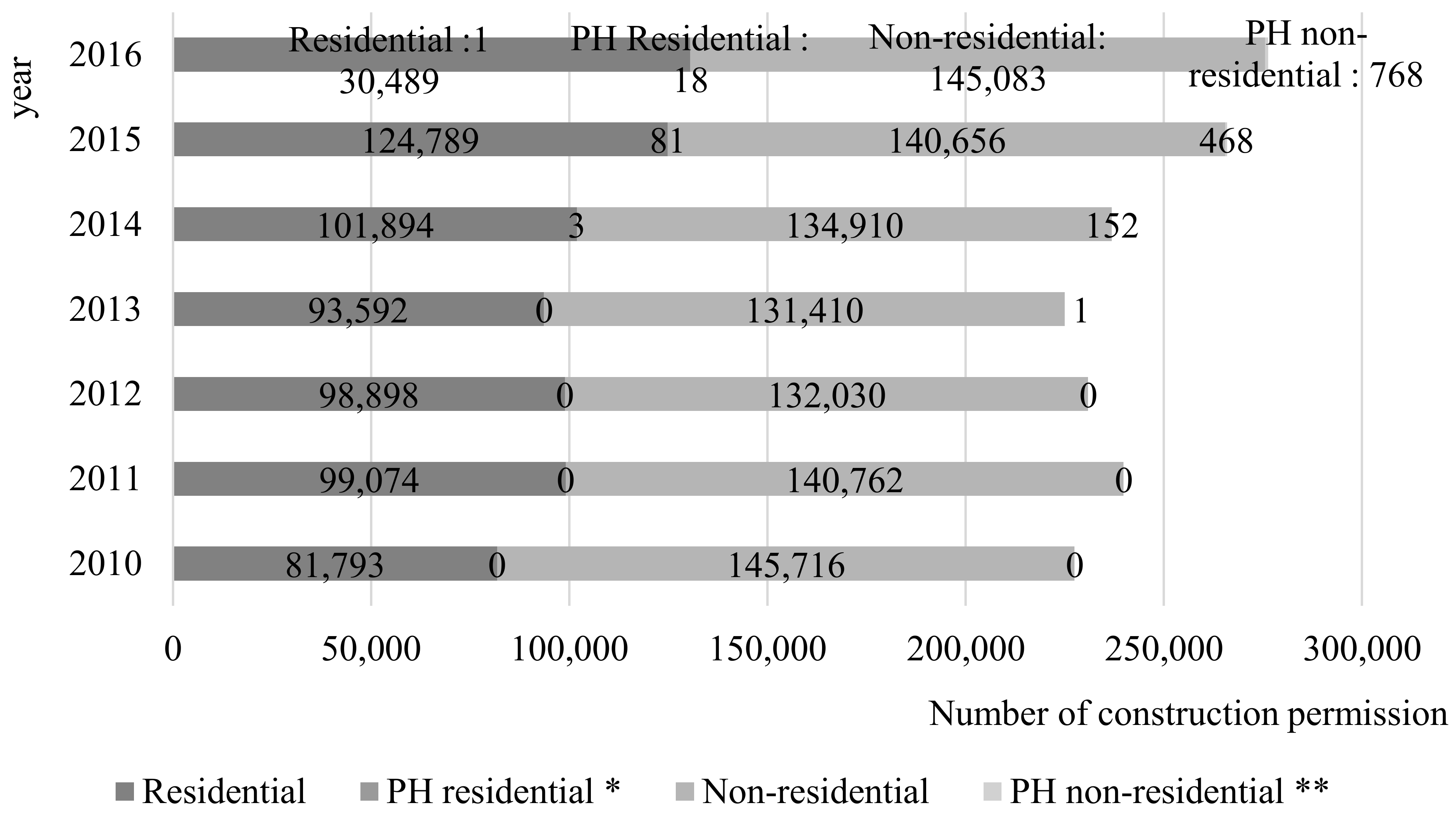
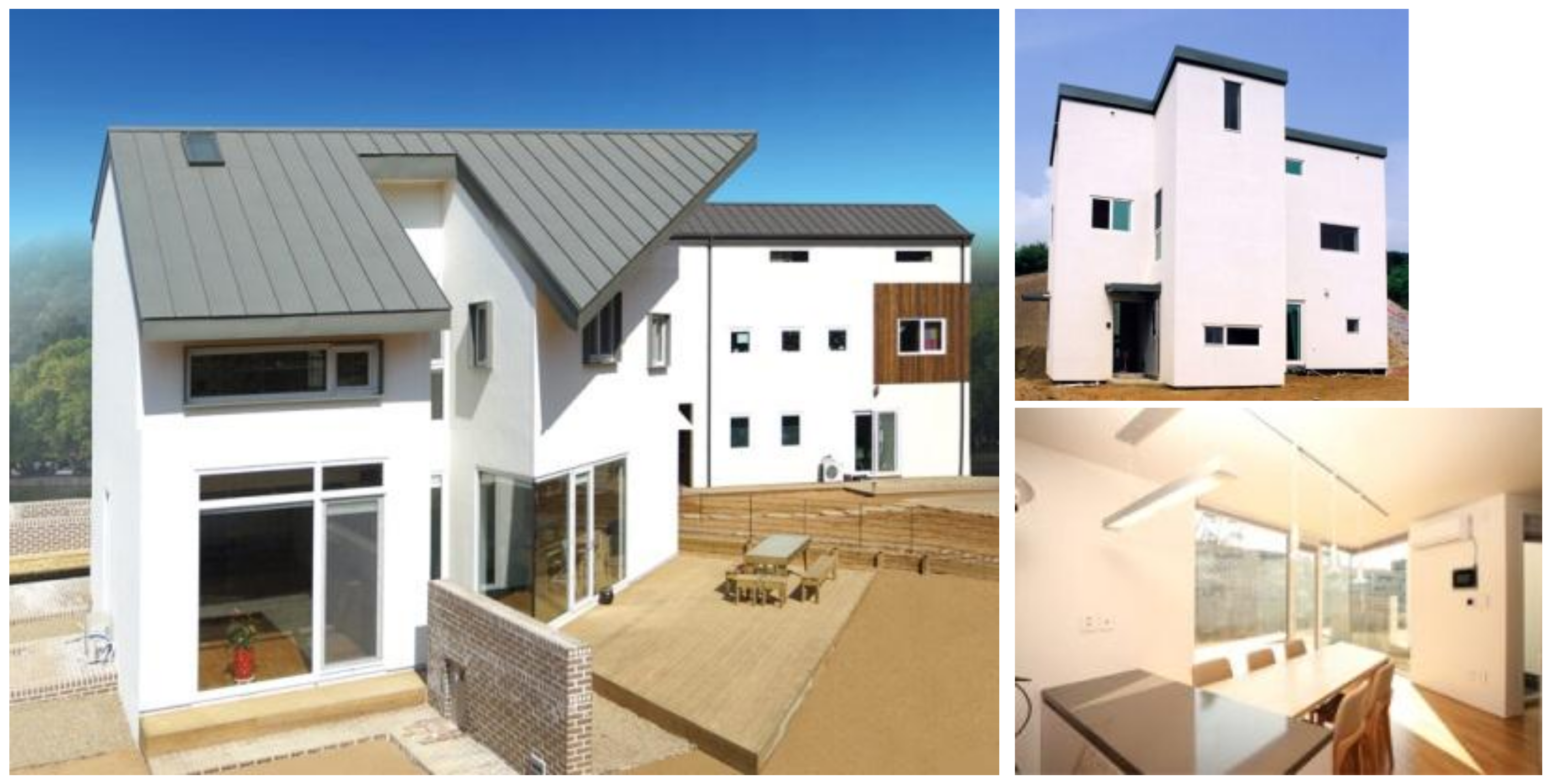
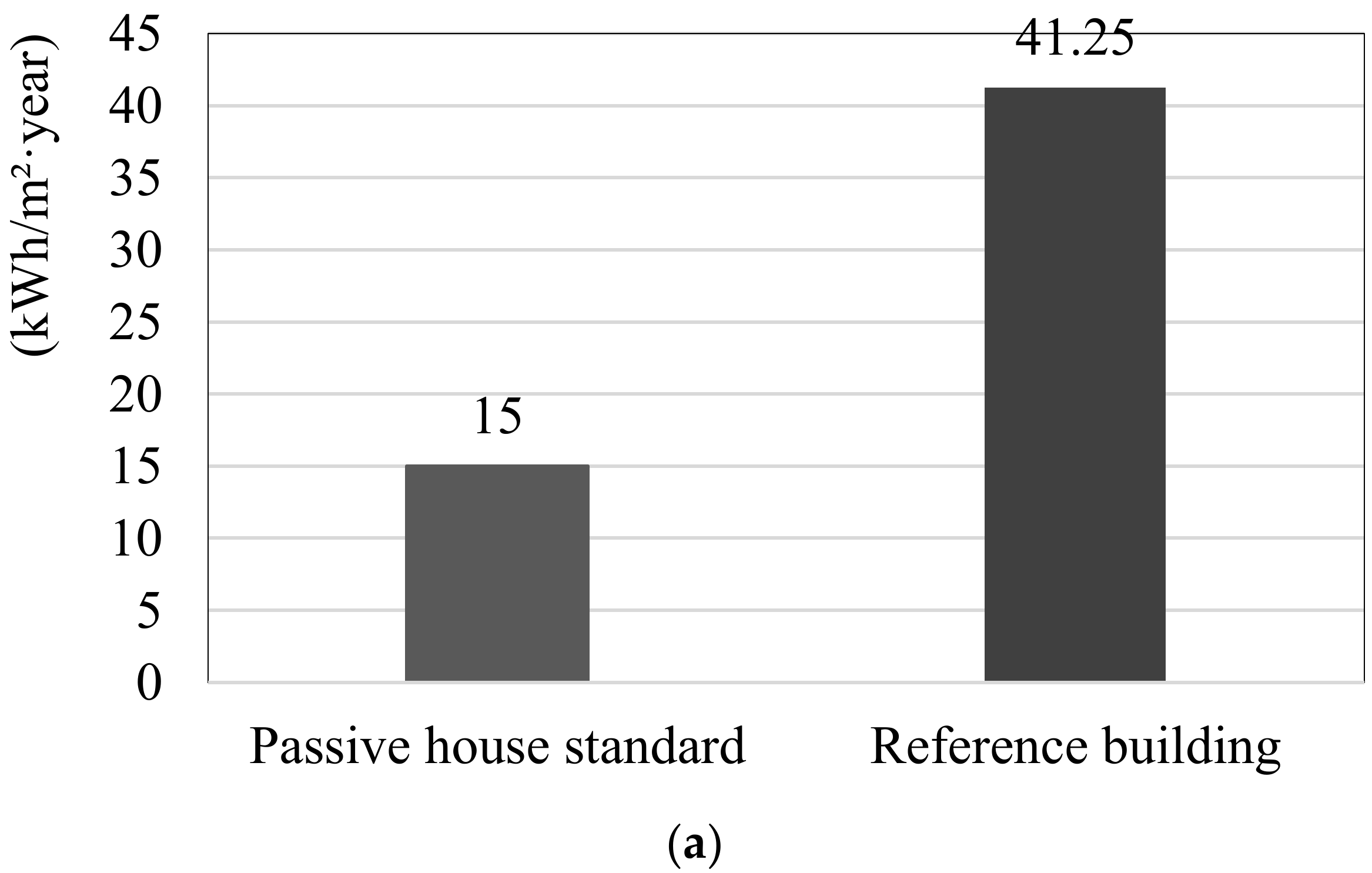
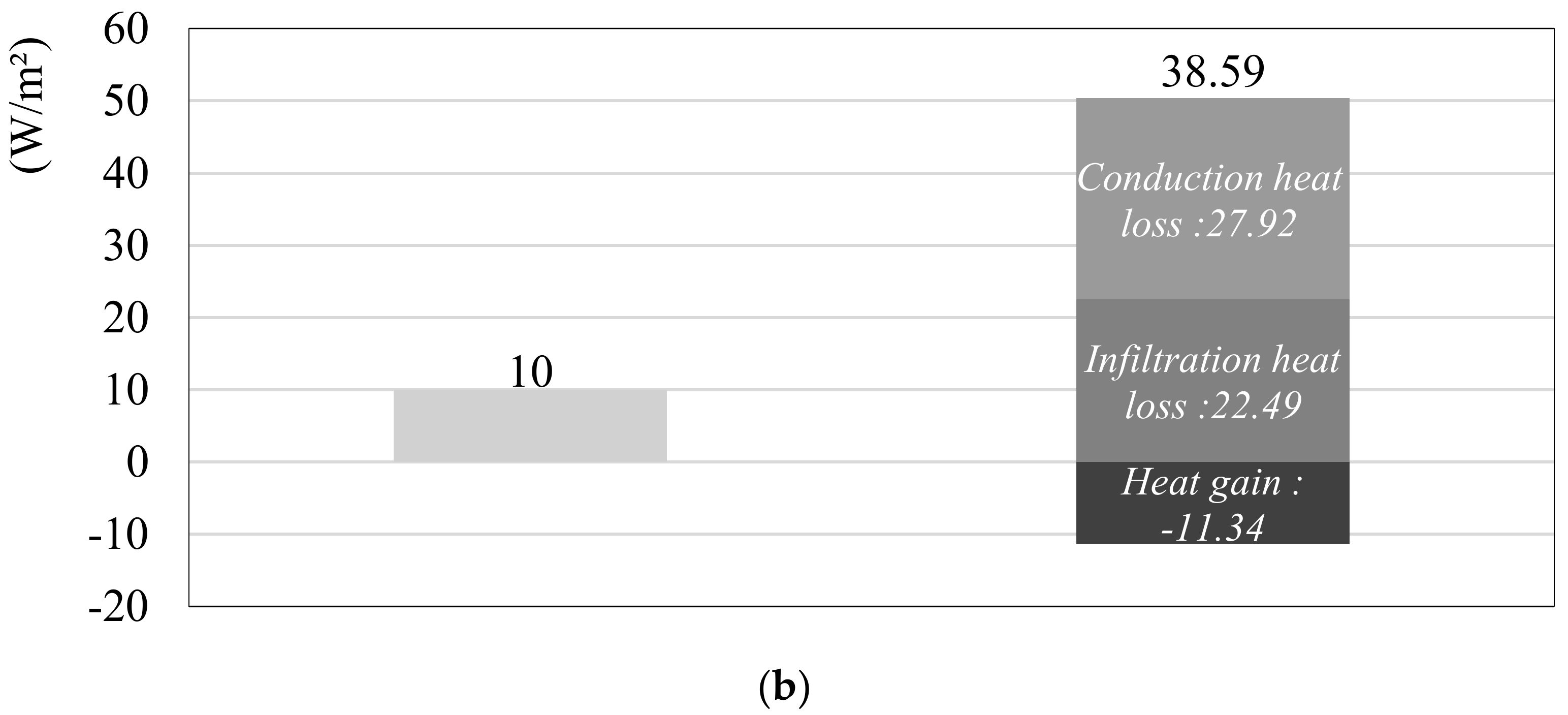
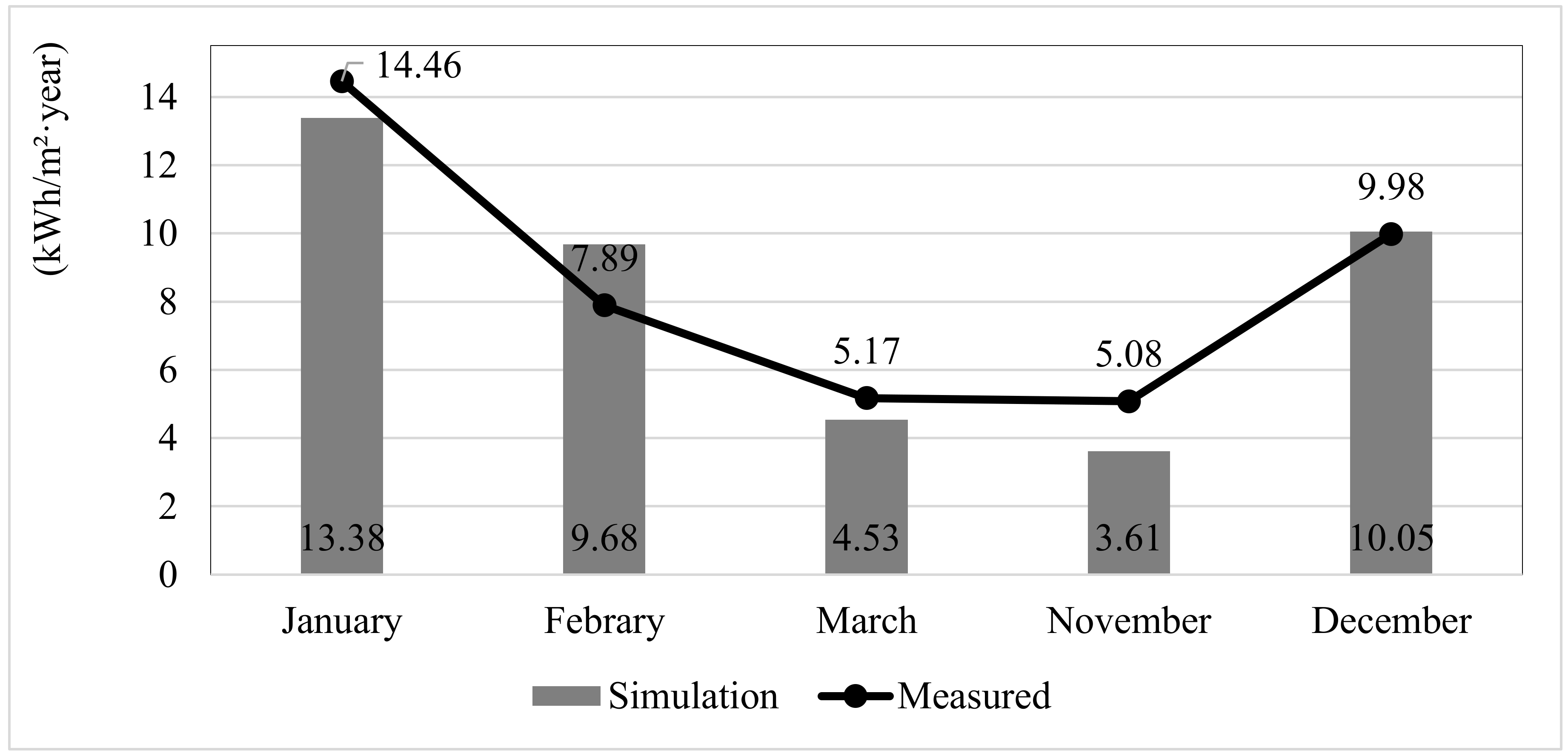

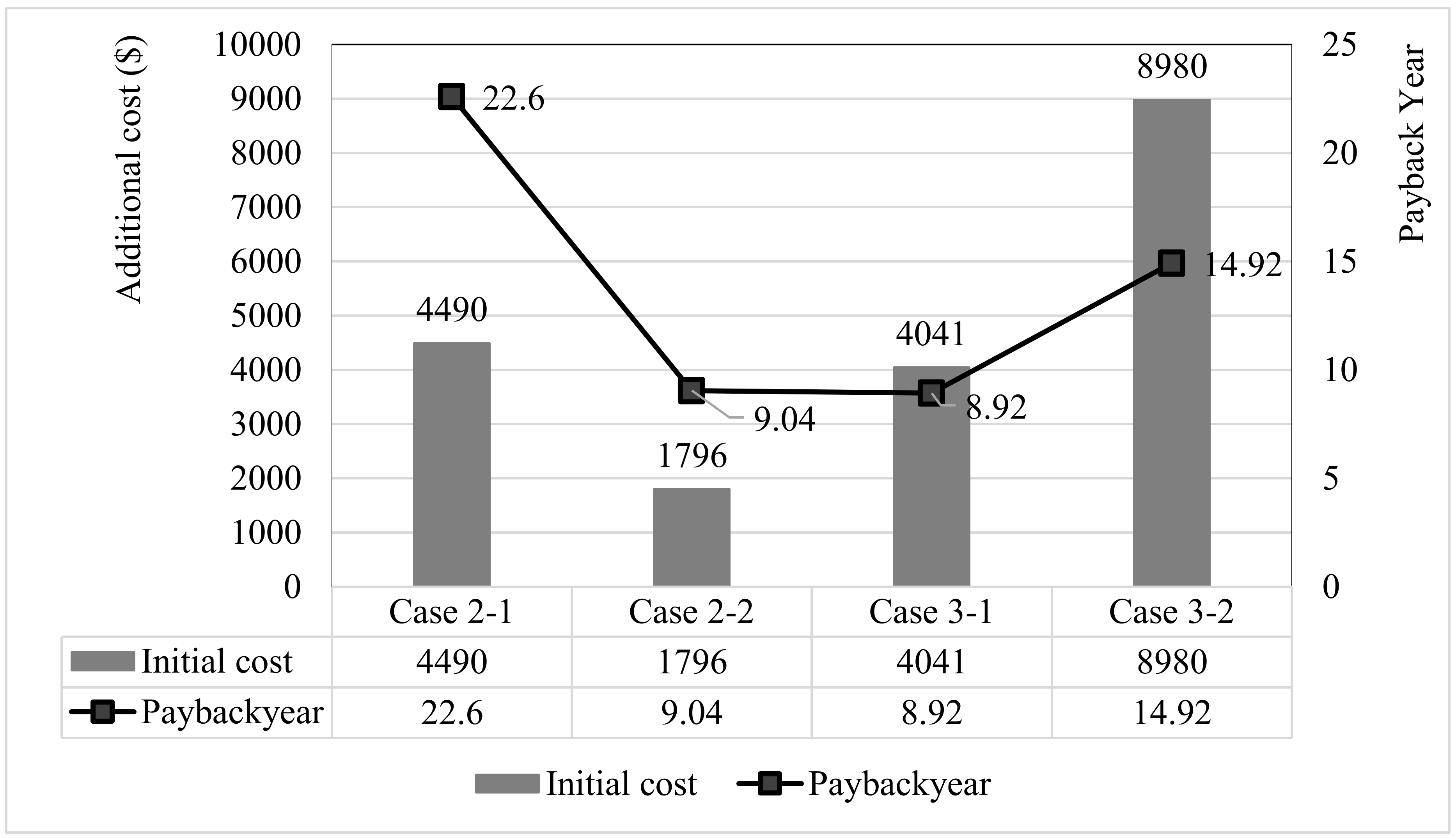

| Level | Residential Buildings | Except Residential Buildings |
|---|---|---|
| Required primary energy per unit area per year (kWh/m2·year) | ||
| 1+++ | <60 | <80 |
| 1++ | 60~90 | 80~140 |
| Level | Renewable (Primary) Energy Rate (%) = (Renewable Primary Energy Generation per Unit Area per Year (kWh/m2·year)/Required Primary Energy per Unit Area per Year (kWh/m2·year × 100 |
|---|---|
| 1 | >100 |
| 2 | 80~100 |
| 3 | 60~80 |
| 4 | 40~60 |
| 5 | 20~40 |
| Outdoor condition | Max/min | Average | ||
| Dry-bulb temp (°C) | 35/−14.7 | 12.15 | ||
| Relative humidity (%) | 100/11 | 68.98 | ||
| Wind speed (m/s) | 6.4/0 | 1.22 | ||
| Solar irradiance (MJ/m2) | 3.03/0.03 | 0.55 | ||
| Designed indoor thermal condition [58] | summer | winter | ||
| Dry-bulb temp (°C) | 26 | 20 | ||
| Relative humidity (%) | 50 | 50 | ||
| Internal heat gain [59] | Lighting (W/m2): 5.5 [56] Equipment (Wh/m2∙day): 52 People (Wh/m2∙day): 53 | |||
| Infiltration rate [57] | 1.0 ACH at 50 Pa | |||
| Ventilation system | uninstalled | |||
| Building component | Material (mm) | Heat capacity [J/kg · K] | U-value [W/m2K] | |
| Exterior wall | Expanded polystyrene (50) | 1210 | 0.160 | |
| Oriented strand board (11) | 1260 | |||
| Glass wool (140) | 960 | |||
| Gypsum board (19) | 1090 | |||
| Inner wall | Gypsum board (19) | 1090 | 0.175 | |
| Glass wool (140) | 960 | |||
| Gypsum board (19) | 1090 | |||
| Ground floor | Strip flooring (8) | 1630 | 0.171 | |
| Plain concrete (64) | 920 | |||
| Extruded polystyrene (50) | 1210 | |||
| Concrete (300) | 920 | |||
| Extruded polystyrene (100) | 1210 | |||
| Blinding concrete (60) | 920 | |||
| 1st floor | Strip flooring (8) | 1630 | 0.114 | |
| Plain concrete (64) | 920 | |||
| Extruded polystyrene (50) | 1210 | |||
| Glass wool (235) | 960 | |||
| Gypsum board (19) | 1090 | |||
| Roof | Oriented strand board (11) | 1460 | 0.146 | |
| Glass wool (235) | 960 | |||
| Gypsum board (19) | 1090 | |||
| Window | Glass | 2.71 | ||
| Frame | 1.59 | |||
| Area (m2) | 36.65 | |||
| SHGC | 0.47 | |||
| HVAC System | Radiant floor heating with thermostat control, Gas-fired (Efficiency: 83%) | |||
| Shape factor | 0.698 | |||
| Type | Interest | Electricity Inflation Rate | Natural Gas Inflation Rate | Core Producer Price |
|---|---|---|---|---|
| Rates | 1.5% [64] | 3.3% [65] | 3.76% [66] | 1.5% [67] |
| ECMs | Infiltration Rate | Ventilation System | ERV (Energy Recovery Ventilator) | Construction | ||
|---|---|---|---|---|---|---|
| Performance | Electricity Demand | |||||
| Case 1 | - | 1.0 [57] | without | without | Conc. | |
| Case 2-1 | Strengthen air-tightness | 0.6 [70] | Wooden | |||
| Case 2-2 | Conc. | |||||
| Case 3-1 | Install ERV | 0 | 0.295 ach [71] | Cooling-effic.: 45%, heating-effic.: 70% [72] | 2.15 kWh/m2·year | Conc. |
| Case 3-2 | Enthalpy heat-effic.: min 75% Elec. power cons.: 0.45 W/m2h [73] | 1.34 kWh/m2·year | ||||
| Cases | ECMs | Structures | Additional Cost (USD) |
|---|---|---|---|
| Case 1 | - | Concrete | 0 |
| Case 2-1 | Strengthen the airtightness | Wooden | 4490 |
| Case 2-2 | Concrete | 1796 | |
| Case 3-1 | Install ERV | Concrete | 4041 |
| Case 3-2 | Install high performance ERV | Concrete | 8980 |
| Base Case | Case 2-1 | Case 2-2 | Case 3-1 | Case 3-2 | |
|---|---|---|---|---|---|
| Initial cost (USD) | 204,963 | (+4490) | (+1796) | (+4041) | (+8980) |
| Energy cost savings (USD/year) | N/A | 198 | 198 | 452 | 602 |
| Energy cost saving rate (%) | N/A | 17% | 17% | 35% | 44% |
| Economic metrics | |||||
| LCC savings (USD) | N/A | −71.18 | 9105 | 10,556 | 7410 |
| LCC saving rate (%) | N/A | −0.03% | 4.39% | 5.13% | 3.54% |
| Payback period (year) | N/A | 22.6 year | 9.04 year | 8.92 year | 14.92 year |
© 2018 by the authors. Licensee MDPI, Basel, Switzerland. This article is an open access article distributed under the terms and conditions of the Creative Commons Attribution (CC BY) license (http://creativecommons.org/licenses/by/4.0/).
Share and Cite
Shim, J.; Song, D.; Kim, J. The Economic Feasibility of Passive Houses in Korea. Sustainability 2018, 10, 3558. https://doi.org/10.3390/su10103558
Shim J, Song D, Kim J. The Economic Feasibility of Passive Houses in Korea. Sustainability. 2018; 10(10):3558. https://doi.org/10.3390/su10103558
Chicago/Turabian StyleShim, Jisoo, Doosam Song, and Joowook Kim. 2018. "The Economic Feasibility of Passive Houses in Korea" Sustainability 10, no. 10: 3558. https://doi.org/10.3390/su10103558
APA StyleShim, J., Song, D., & Kim, J. (2018). The Economic Feasibility of Passive Houses in Korea. Sustainability, 10(10), 3558. https://doi.org/10.3390/su10103558






